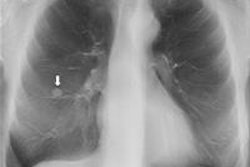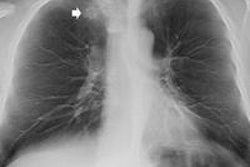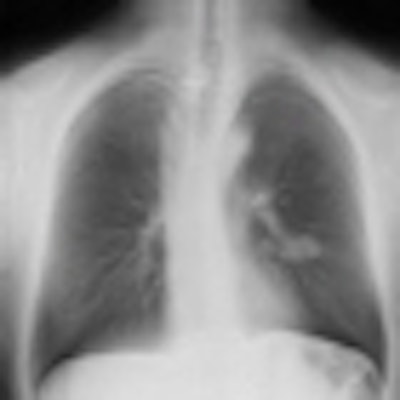
In the continuing battle to improve patient care standards and lower healthcare spending, healthcare providers and vendors are looking to utilize current technology in new cost-effective ways. A recent example of this is evident in the array of new general radiography x-ray and digital tomosynthesis (DT) combined systems available. Recent clinical studies have shown the benefits of combining DT with conventional x-ray, most notably in the detection of cancerous lung nodules. Even better, DT can also reduce cost and free up advanced imaging resources. Below are a few key considerations impacting the uptake of DT in the next three years.
DT chest screening protocol
One of the conventional uses of x-ray chest imaging is lung cancer screening. However, any abnormal finding often leads to a second scan using a full CT scanner. With DT, the need for follow-up CT scans could be removed for many cases. DT provides a higher resolution image compared with general radiography x-ray alone, albeit at a lower resolution than CT. This enables physicians to make a clearer diagnosis from the initial x-ray and DT scan, reducing the number of patients sent for follow-up CT scans. Researchers have found that detection rates when using DT are comparable with CT. In terms of dose, DT in a chest exam is around three times more than digital x-ray alone, but is three times less than chest CT. With patient dose awareness at its peak, limiting the use of high-dose CT will be welcomed by providers and patients alike.
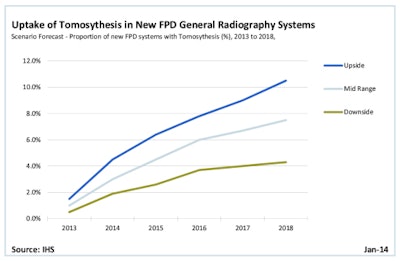
Reimbursement
In the U.S., there is currently no specific code for DT as part of an x-ray scan. However, reimbursement is applied if classified as an unlisted diagnostic x-ray procedure. Recently, U.S. Medicare and Medicaid services released proposed outlining CT reimbursement to be cut 38% this year, the eight year in a row that CT has been cut. In Europe, uncertainty also surrounds the reimbursement of DT with general x-ray scans. Hospitals and imaging centers are, therefore, looking for alternative ways to achieve the same results using different modalities. In some cases, cone-beam CT and ultrasound are being used as alternatives to CT and MRI. What is clear at this stage is that lack of clear reimbursement guidelines for DT will hinder large-scale adoption in the near future. However, with CT rates now declining heavily, many savvy healthcare providers may still adopt DT without reimbursement, as long as savings in efficiency, workflow, and less pressure on CT resources can be maximized.
Other applications
To date, DT application has focused on identification of lung nodules. However, research into the benefits of using DT during abdominal, spinal, and orthopedic exams is ongoing. Conventional CT has limited functionality for orthopedic use due to the inherent limitations of system resolution. Conventional radiography techniques are also unable to easily distinguish 3D structures. DT in addition to general radiography offers an intriguing compromise; it is able to provide improved resolution in the spatial plane, while also allowing 3D volumetric imaging. Recent studies have shown that using DT has aided in detecting small fractures unclear though with conventional 2D scans. Arthritis may also be an area where DT could aid screening programs. Using DT in combination with conventional x-ray provides greater visibility of joint space, a fundamental aspect of monitoring the development of the disease.
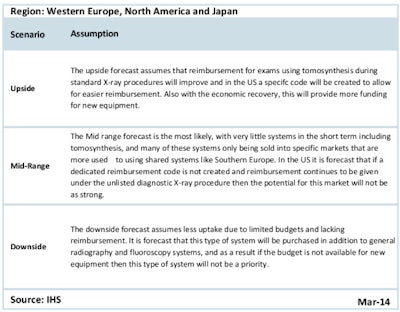
Conclusion
There is significant hype regarding DT combined with x-ray currently, spurred by healthcare providers' need for cost saving solutions. Continued pressure on reimbursement in the CT market is also putting pressure on imaging centers and hospitals in finding alternative image modalities. In the short term, few hospitals have the budget to buy new DT conventional x-ray systems. Lack of clarity for reimbursement will also hinder uptake. Longer term, as current general radiography systems need replacing, adoption of DT will increase, reducing reliance on CT. This is due to the multiple benefits DT offers for healthcare providers and patients: reduced radiation dose and inconvenience of secondary scanning for the patient, and reduced cost and lower demand on centralized CT for the hospital. While use of DT will certainly not completely remove the need for CT in more complex cases, its use as a frontline tool for lung cancer detection is gaining momentum. If specific reimbursement for DT is approved and CT funding continues to decline, the case for DT will become even more compelling.
Sarah Jones is an analyst with Medical Devices & Healthcare IT, HIS.
Originally published in ECR Today on 10 March 2014.
Copyright © 2014 European Society of Radiology




